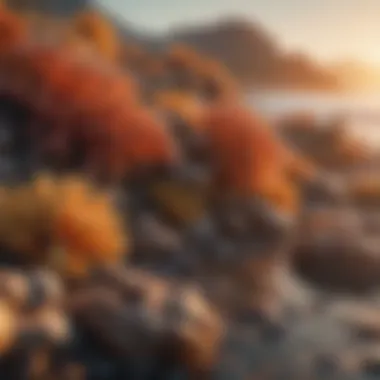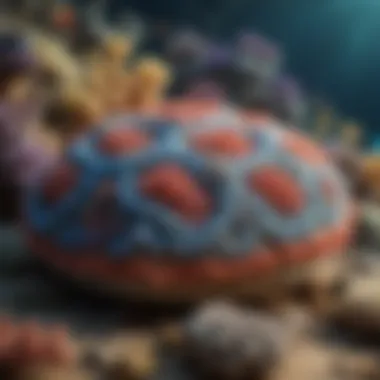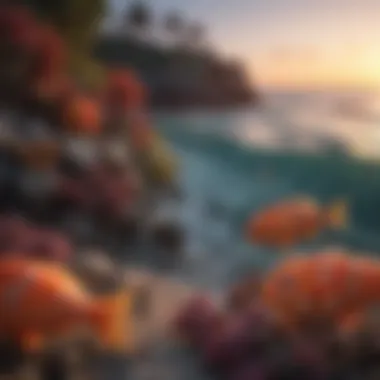Reef Cushions at Dawn: Ecological Significance


Intro
Reef cushions, soft formations often found on coral reefs, are significant structures in marine ecosystems. Their role becomes particularly fascinating at dawn. This time of day, with its special light conditions, alters both visibility and marine behavior. As the sun rises, the interplay of light and water creates unique opportunities for marine species and the adventurers who seek to explore these underwater landscapes.
Not only do reef cushions provide structural support for a myriad of marine life, but they also serve as a habitat for countless organisms. With the early morning light enhancing visibility, divers and snorkelers can observe a world that awakens in exquisite detail. This article will guide you through the nuances surrounding reef cushions and their ecological implications, enriching your underwater experience.
Techniques and Tips
Exploring reef cushions requires understanding the environment and developing specific skills. Here are some techniques and tips to enhance your experience.
Skill Development
Learning the basics of snorkeling or diving is important before engaging with reef cushions. Focus on buoyancy control and breath-holding techniques, which help maintain a stable position while observing marine life. Practicing these skills in shallow waters will prepare you for deeper excursions.
Practical Techniques
- Slow Movement: Approach slowly to minimize disturbance. Rapid movements can startle fish and other creatures.
- Observe Lighting: Take note of the angle of sunlight. This influences the visibility and the colors of the reef.
- Use a Camera Handle: For excited photographers, using a camera handle can reduce arm fatigue during long underwater sessions.
Common Mistakes to Avoid
- Ignoring Safety Protocols: Always prioritize safety by sticking to diving or snorkeling guidelines.
- Touching Marine Life: Many organisms are sensitive. Touching them can cause damage both to them and the reef.
- Overpacking Gear: Bringing too much equipment can impede mobility. Aim for efficiency with essential gear only.
Gear and Equipment
Having the right gear when exploring reef cushions is crucial for both safety and enjoyment.
Essential Gear for Beginners
- Wetsuit: Provides warmth and protection from the sun.
- Mask and Snorkel: Ensures clear visibility and easy breathing underwater.
- Fins: Help with propulsion and maneuvering without excessive effort.
Latest Innovations and Trends
Recent advancements in equipment have made underwater exploration more accessible. Masks with integrated snorkels, for instance, allow for easier breath control. Compact dive computers also help monitor depth and safety without cumbersome gear.
Reviews and Comparisons
Choosing gear can be overwhelming. Researching options on platforms like Reddit can provide valuable user feedback.
Safety Measures
Safety while exploring reef cushions cannot be overlooked. Here are vital precautions you should follow:
Essential Safety Gear
- Life Jacket: Enhances buoyancy, especially for novices.
- Dive Knife: For emergency situations, though it should only be used responsibly.
Best Practices for Safe Participation
- Buddy System: Always dive with a companion.
- Before Diving Check: Inspect equipment thoroughly.
- Plan Your Dive: Understand the area and plan your exploration route.
Injury Prevention and Management


While exploring, be aware of potential injuries like cuts from sharp coral or encounters with marine life. Carry a basic first-aid kit for minor injuries. Familiarize yourself with how to manage these situations beforehand.
"Reef cushions are not just structures; they are ecosystems that thrive on balance and harmony."
Spotlights on Extreme Sports
Incorporating the thrill of extreme sports can enhance your experience in marine environments.
Featured Sport of the Month
This month, we highlight Freediving. This sport requires exceptional skills in breath control and equalization. Freedivers often explore reef cushions, allowing them to observe marine life up close without the restriction of bulky equipment.
Profiles of Prominent Athletes
Explorers like Umberto Pelizzari, renowned for his deep dives and educational efforts, emphasize the importance of safety and technique while navigating underwater landscapes.
Understanding reef cushions at dawn opens up a world of natural beauty and extreme adventure. By honing your skills, choosing the right gear, prioritizing safety, and engaging with extreme sports, you can maximize your experiences in these unique marine environments.
Preface to Reef Cushions
Rreef cushions are vital marine structures that play a significant role in underwater ecosystems. Understanding these cushions is essential as they not only support a diverse range of marine life but also influence the health of coral reefs. This section delves into what reef cushions are, their defining characteristics, and their importance in marine ecosystems.
Definition and Characteristics
Rreef cushions are defined as specific, naturally occurring formations of marine organisms, often found at the base of coral reefs. They are typically composed of corals, sponges, and various forms of algae. One key characteristic is their soft, sponge-like texture. This unique texture helps them absorb waves and protect the fragile structures of the reefs. Additionally, their coloration can vary significantly depending on the composition of the organisms residing within them, presenting an array of vibrant hues that attract both fish and divers.
Importance in Marine Ecosystems
Rreef cushions are crucial habitats for numerous marine species. They provide shelter and breeding grounds for small fish, crustaceans, and invertebrates. The interaction among these organisms creates a complex food web, supporting larger predators such as snappers and groupers. Furthermore, these cushions contribute to nutrient cycling within the ecosystem, promoting biodiversity. They also serve as a natural barrier that minimizes erosion of the reef structures.
The Natural Formation of Reef Cushions
The natural formation of reef cushions plays a crucial role in understanding the delicate balance of marine ecosystems. These structures are not merely a result of random environmental factors; they arise through specific biological and ecological processes. The interdependence between living organisms and the surrounding environment influences how reef cushions develop. By comprehending these elements, adventurers and researchers can better appreciate the importance of these habitats.
Biological Contributions
Biological contributions are essential in the formation of reef cushions. Various marine organisms play roles that directly affect the structure and stability of these formations. For instance, coral polyps are significant builders; they secrete calcium carbonate, creating a rigid framework that supports numerous ecosystems. This hard structure acts as a foundation where many aquatic species find shelter and food.
Additionally, other marine organisms such as mollusks and sponges add to the complexity of the reef cushion. They provide surfaces for other organisms to attach. This relationship not only enhances biodiversity but also supports a variety of life forms. The cumulative impact of these organisms establishes a habitat that can weather environmental challenges.
"Reef cushions are more than just structures; they are vibrant ecosystems that support a myriad of life forms, each with a role to play."
Environmental Factors Affecting Structure
Environmental factors largely dictate the formation and sustainability of reef cushions. Various considerations impact how these structures evolve over time. Temperature variations, for instance, can influence coral growth rates and health. Warmer waters may support faster growth, but they also risk bleaching events that can devastate entire coral populations.
Salinity levels also have profound effects. Fluctuations can disrupt the delicate balance required for reef organisms to thrive. Additionally, wave action plays a critical role; significant waves can break coral and alter reef formations.
In summary, the interplay of biological contributions and environmental factors is fundamental to the formation of reef cushions. Recognizing these aspects can deepen appreciation for these complex underwater gardens, as well as inform efforts in conservation and sustainable practices.
Dawn: A Crucial Moment
Dawn represents a pivotal period for reef cushions and the marine life associated with them. As the sun rises, the ecosystem undergoes crucial changes. This transition time not only transforms the physical environment but also influences the behavioral patterns of the creatures inhabiting these coral formations. Understanding this window is essential for adventure enthusiasts who seek to engage with the marine world during this magical hour.


The morning light plays a key role in enhancing visibility under the water. The angle at which sunlight penetrates the surface affects how colors and textures are perceived. For snorkelers and divers, this means clearer views of the vibrant sea life that call these reef cushions home. The illumination can provide the perfect backdrop for observing and photographing various species, contributing to a memorable experience.
Moreover, the calmness of dawn creates a unique opportunity for participants in extreme sports. Often, during this time, water conditions are more stable, reducing waves and currents. Consequently, this enhances safety and increases the likelihood of an enjoyable exploration.
Lighting and Visibility
Lighting at dawn offers significant advantages for both marine ecosystems and the individuals exploring them. As natural light gradually increases, it reveals intricate details of the reef cushions. This visibility not only aids in spotting marine species but also in understanding their interactions with the environment. Bright conditions allow for more precise observations, which is invaluable for photographers, researchers, and thrill-seekers alike.
Some key points about lighting at dawn include:
- Color Enhancement: The unique quality of dawn light amplifies the colors of coral and marine life, offering a stunning visual experience.
- Visibility Range: Underwater visibility tends to increase as the sun rises, allowing observers to see further and clearer. This is beneficial for locating specific species or stunning coral formations.
- Reflections: The gentle morning light creates captivating reflections on the surface, adding to the aesthetic beauty of the underwater landscape.
Behavioral Changes in Marine Life
Dawn initiates a shift in the behavior of marine organisms. Many species become more active as they respond to the increasing light and changing conditions. For example, some fish species engage in feeding frenzies during this time, taking advantage of the more abundant prey. This behavior presents an ideal opportunity for viewers to watch the interactions of these creatures in their natural habitat.
Moreover, the calmness associated with dawn often leads to increased visibility of larger species, like turtles or rays, that may normally hide from the currents and wave actions throughout the day. They may venture out to explore or bask in the morning warmth.
Important behavioral aspects during dawn include:
- Feeding Patterns: Many fish and invertebrates exhibit increased feeding, making the reef a dynamic site for observing predator-prey interactions.
- Nesting Activities: Certain aquatic creatures take this time to engage in nesting behaviors, creating a rich tapestry of life and engagement.
- Predator Prey Dynamics: The interactions among species become more pronounced, providing opportunities to witness how animals adapt in relation to their predators or prey.
"The dawn period is much more than just a beautiful sight. It is a crucial time that affects the dynamics of life within reef ecosystems. Understanding these rhythms can greatly enhance the adventure of exploring them."
Reef Cushions and Extreme Sports
Rreef cushions hold a significant place in the realm of extreme sports. Their unique formations and structures create an underwater world that is both captivating and challenging for thrill-seekers. Understanding these formations is not merely an academic exercise; it has real implications for safety, enjoyment, and technique in activities such as snorkeling and diving. By integrating the characteristics of reef cushions into extreme sports practices, enthusiasts can enhance their experience and ensure a greater degree of environmental awareness.
Snorkeling Experiences
Snorkeling over reef cushions offers a vibrant and immersive experience for participants. Early morning light can illuminate the myriad of colors found in the marine flora and fauna that thrive among these structures. Visibility is often optimal during dawn, allowing snorkelers to view schools of fish darting in and out of nooks formed by the cushions.
Key Considerations for Snorkeling:
- Safety First: Check conditions before entering the water. Strong currents can be dangerous.
- Equipment: Use a good quality mask and snorkel. A floatation vest may assist beginners in adopting a more relaxed posture while exploring the reef.
- Respect Nature: Avoid touching or standing on reef cushions. They are delicate ecosystems essential to marine life.
Noteworthy, many snorkeling tours place great emphasis on the educational aspect of this activity. Enthusiasts learn about the species that inhabit the reef and understand their roles in maintaining ecological balance. This makes the snorkeling experience not just about adventure, but also about enriching knowledge and fostering a sense of stewardship towards marine environments.
Diving Techniques Around Reef Cushions
Diving near reef cushions requires specific techniques that enhance not only safety but also the experience itself. As divers descend, understanding the topography of the reef is crucial. The varied structures create several niches and crevices that serve as habitats for diverse marine species.
Important Techniques for Diving:
- Controlled Descent: Utilize a slow, controlled descent technique to minimize agitation of sediment and maintain visibility.
- Buoyancy Control: Practice buoyancy techniques to hover near the reef cushions without causing damage.
- Communication: Use hand signals effectively with your diving partner to maintain a clear line of communication.
Another aspect of diving is the focus on teamwork. Group diving around reef cushions can enrich the experience as divers can share observations and highlight various marine life. Participating in small groups not only ensures safety but also fosters appreciation for this diverse underwater world.
Conservation of Reef Cushions
Conservation of reef cushions is critically important for maintaining biodiversity and ensuring the health of marine ecosystems. These structures not only provide vital habitats for various species but also play an integral role in protecting shorelines from erosion and mitigating climate impacts. Understanding the challenges faced by reef cushions is essential for developing effective conservation strategies that benefit both marine life and human communities dependent on these resources.


Threats to Reef Structures
Several factors threaten the integrity of reef cushions. The foremost issue is climate change, which alters water temperatures and salinity levels. Increased temperatures can lead to coral bleaching, a phenomenon where corals expel the algae living in their tissues, resulting in a white appearance and decreased health.
Other significant threats include pollution from agricultural runoff, which introduces harmful chemicals into the ocean. This runoff can cause algal blooms, choking oxygen from the water and leading to dead zones where marine life cannot survive. Additionally, overfishing disrupts the balance of marine ecosystems, further putting pressure on reef structures.
Key Threats Include:
- Climate Change and Coral Bleaching
- Pollution from Surface Runoff
- Overfishing and Habitat Destruction
- Invasive Species Disruption
Sustainable Practices for Preservation
To combat these threats, sustainable practices must be adopted and promoted. Effective measures can enhance resilience in reef ecosystems, allowing them to survive climatic and anthropogenic pressures. Some successful strategies include:
- Marine Protected Areas (MPAs): Establishing MPAs can limit human activities that damage reefs, allowing ecosystems to recover and thrive.
- Regulated Fishing Practices: Imposing catch limits and using sustainable fishing gear helps maintain fish populations that are essential for reef health.
- Pollution Control Initiatives: Implementing stricter regulations on waste management and promoting eco-friendly agricultural practices can reduce runoff and improve water quality.
- Community Engagement and Education: Raising awareness among local communities about the importance of reef conservation encourages collective efforts to protect these ecosystems.
"Effective conservation begins with education and understanding the true value of these fragile ecosystems."
The commitment to sustainable practices is essential for ensuring that reef cushions can withstand the pressures they face.
Case Studies: Successful Preservation Efforts
Understanding the complexities of reef cushions extends beyond theoretical knowledge and ecological importance. It is essential to examine successful preservation efforts that have emerged in response to the threats facing these delicate marine structures. Case studies provide concrete examples of how communities and organizations have taken action to protect reef cushions, demonstrating both the benefits and challenges inherent in these efforts. They show the potential for restoration and conservation when proactive measures are implemented.
Local Initiatives and Their Impact
Local initiatives often serve as the frontline in the battle for conservation. These efforts typically stem from community engagement and awareness. For instance, in the Coral Triangle, localized programs involve indigenous communities in monitoring reef health. Fishermen are trained to identify signs of degradation, which allows for timely interventions.
The benefits of such initiatives include:
- Enhanced local employment related to conservation activities
- Increased awareness among younger generations about marine ecosystems
- Creation of marine protected areas (MPAs) that limit destructive fishing practices
Moreover, studies show that areas with active local initiatives often experience higher biodiversity levels. Engaged communities contribute valuable knowledge that can lead more effective solutions.
Global Perspectives on Reef Conservation
On a broader scale, global perspectives on reef conservation reveal the interconnectedness of these ecosystems. For example, organizations like The Ocean Conservancy and Coral Triangle Initiative focus on multi-nation strategies for preserving reef structures. These programs encourage countries to work together, sharing resources and technologies to combat challenges like climate change and pollution.
Global perspectives emphasize several important themes:
- Collaboration: Successful preservation efforts often involve partnerships between governments, NGOs, and private sectors.
- Research and Technology: Innovations in marine research have provided tools that enhance monitoring practices and restoration efforts.
- Policy Frameworks: Stronger regulations at an international level can enforce protective measures and commitment to conservation.
"In order to save our reefs, we must recognize that our efforts must be collective and informed by scientific research and local knowledge."
These global efforts are essential in addressing the large-scale threats faced by reef cushions. By learning from diverse case studies, stakeholders can develop effective strategies for conservation that resonate at both local and global levels. The balance between human usage and ecosystem preservation is critical for maintaining the health of reef cushions and the marine life they support.
End: Connecting with Nature
In the final analysis, the exploration of reef cushions, particularly during dawn, reveals not only the intricate relationships within marine ecosystems but also the profound connection humans experience with nature. This section ties together the insights gleaned from previous discussions on the biological formations, the effects of early morning light, and the significant roles these structures play in recreational activities like snorkeling and diving. By understanding these components, we gain a holistic perspective on the delicate balance of marine life and the importance of preserving these ecosystems for future generations.
Integrating Learning and Adventure
For thrill-seekers and extreme sports enthusiasts, engaging with reef cushions transcends mere recreation; it represents an opportunity to learn about marine biology and ecology in an immersive environment. Each dive or snorkeling trip becomes an educational journey. Participants can witness firsthand the biodiversity supported by the reef cushions. Integrating knowledge with adventure allows individuals to appreciate the importance of environmental stewardship while satisfying their craving for exploration. This synergy enhances the overall experience and fosters a deeper respect for marine ecosystems.
The Role of Enthusiasts in Conservation
Enthusiasts play a crucial role in the conservation of reef cushions. Their passion often fuels awareness campaigns and local initiatives focused on preserving these vital ecosystems. When adventure lovers actively participate in conservation efforts, they become ambassadors for reef preservation. Moreover, by spreading information about sustainable practices, they can encourage others in the community to adopt environmentally friendly behaviors. Collective actions, driven by passionate individuals, can lead to significant positive impacts on underwater environments.
"The connection between people and nature is vital for musring effective conservation strategies. Enthusiastic engagement leads to informed actions that protect our precious ecosystems."







